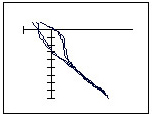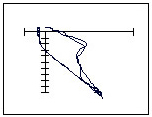
The Anterior “Kick-Out” During Active Leg Extension in the ACL Deficient Knee
William I. Sterett, Jeanne M. Schultheis, Dennis D. O’Connor, J. Richard Steadman
Introduction: ACL deficient knees have decreased stiffness and subsequently increased translation during Lachman testing with mild knee flexion. It is unclear whether this increased translation is consistent at all angles of flexion, particularly during active range of motion. The purpose of this study was to prospectively evaluate the effect of isokinetically firing the quadriceps on displacement of the tibia during leg extension.
Methods: Six ACL deficient subjects underwent dynamic translation testing of the tibia during active leg extension. The normal, uninjured leg was also tested. Three trials on each leg were performed. Total maximal translation was measured, and side-to-side differences were calculated. The femoral-tibial angle where maximal translation occurred was recorded.
Results:
Normal ACL

Deficient ACL

Total maximal anterior tibial translation in the ACL deficient knee averaged 12.7 mm (range 10.4-21.1 mm), and 6.1 mm in the normal knee occurring at 20 degrees knee flexion angle during active knee extension. Maximal side-to-side difference occurred consistently between 40-10 degrees knee flexion angle, with a maximum of 6.6 mm at 20 degrees of flexion. In the ACL deficient knee, a consistent “kick-out” occurred at approximately 20 degrees with a sudden increase in translation during routine leg extension. 5.4 mm of increased translation between 40-20 degrees accounted for nearly 50% of the total tibial translation. This “kick-out” was not seen in any of the normal knees, and in all of the ACL deficient knees.
Conclusion: A reproducible and specific finding of a sudden increase in tibial translation is seen between 40 and 20 degrees during active leg extension in the ACL deficient knee. We feel this “shape of the curve” is often more predictive of ACL insufficiency than the amount of tibial translation. This study confirms that the most effective method of detecting side-to-side differences of anterior tibial translation due to ACL insufficiency is at 20 degrees of knee flexion.

